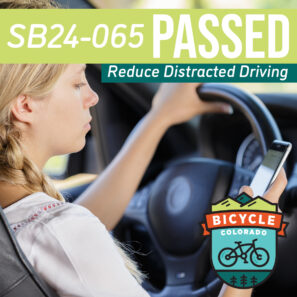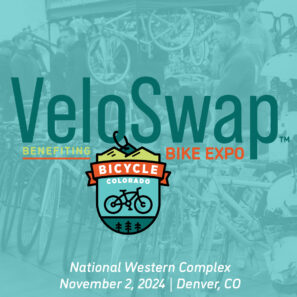Lessons from one of the world’s most bicycle-friendly cities
Piep and Jack, our policy team, spent June 11-14 in one of the world’s most bicycle-friendly cities—Copenhagen—as attendees of the Downtown Denver Partnership’s Denver Urban Exploration trip. The trip was made possible with funding from our friends at PeopleForBikes, who also had five staff members in attendance at the conference.

The Bicycle Colorado policy team
Denver Urban Exploration is a yearly opportunity for civic, community and business leaders from the city to take a look at what other cities are doing well—and what they aren’t—and see what can be applied in Denver. One thing that Copenhagen is doing as well as (or better than) anyone? Being a bike-friendly city. That’s why the Downtown Denver Partnership provided every conference attendee with a free bike rental for the duration of the conference.
Before providing a run through of the sessions Bicycle Colorado participated in, here are a few facts about bicycling in Copenhagen:
- Copenhagen has nearly 300 miles of elevated cycle tracks (compared to about 18 miles of painted bike lanes), green cycle routes and cycle superhighways
- 49% of people in the greater Copenhagen area commute by bike every day
- That number rises to 62% in central Copenhagen
- 75% of the people represented above continue riding in rain, snow and other adverse weather conditions
- Only nine percent of people in Copenhagen commute by car
- The car was king in Copenhagen, too, before city leaders and residents decided they wanted a different way of life, as recently as the 1970s (just take a look at the two images below!)


While there were several tracks to participate in on Denver Urban Exploration—including tracks focused on the local economy, architecture or affordable housing—we spent our time focused on mobility, which tied in to everything else discussed at the conference as well. We spent the majority of our time in the city riding bikes, exploring and experiencing the city’s infrastructure at all times of day and discussing what Denver can adopt here.
Day one in one of the world’s most bicycle-friendly cities
The conference began on Tuesday with a bike ride from our group hotel to the Danish Architecture Center—a stress-free, mile-long ride most of the 140 attendees participated in. The ride was followed by two presenters discussing how Copenhagen has changed in recent years to become the “Copenhagen” we think of today: bike-friendly and among the most climate-conscious cities in the world.
It took conscious, thoughtful decision-making from the city’s leadership and citizens to make changes like removing car parking to make Stroget, the city’s world famous walking mall, what it is today.
According to the first presenter, Anders Larsen of DIS, Copenhageners began asking themselves “what kind of future do we want?” in the 1950s, and the answer was to live in a thriving city—bicycling played a big part in that.
Following the first presentations of the conference, Larsen led the group on an architectural and historical canal tour of the city, our first experience with some of the bike- and pedestrian-exclusive infrastructure the city has to offer, like the “key bridge,” which you can see below.
Day two
Day two began with three presentations to the whole group in the morning from Frank Jensen, the Lord Mayor of Copenhagen; Tim Blumenthal, president of PeopleForBikes; and Klaus Bondam, director of the Danish Cycling Federation.
Each of the presentations focused on making the city a more livable place, with Blumenthal discussing the many opportunities we have for growth in Denver, and Bondam noting the importance of infrastructure that works for everyone, not just confident and experienced commuters.
Bondam used his platform to remind Denver city leaders that there is financial benefit in bicycling, and that the city needs courageous politicians to make Copenhagen’s model a reality in Denver. He even asked city leaders to take the car down from its pedestal and treat other modes of transportation as equally viable.
Other reminders from Bondam included:
- it costs money to create effective bike infrastructure, but that’s an investment in your city and residents
- bicycling and walking should be integrated into all mobility discussions
- policies and visions should be created to achieve goals to make any city more bikeable and livable
We spent the remaining two sessions of the day bicycling around the city in 30-person groups, led by the Danish Cycling Embassy and PeopleForBikes. Stops on our infrastructure tour included:
- intersections with lights only for bicyclists
- road-side pedestals so bicyclists don’t have to step off pedals when waiting for a light to change
- tilted trash cans for bicyclists to discard trash easily while on the move
- the Queen’s Bridge, which is used daily by 48,000 bicyclists—an astounding number
- underground parking you can ride in and out of
- massive elevated bike lanes
- the full bike parking area outside of the Danish Parliament (many politicians ride in daily)
- two-way lanes through parks
- and a bikeway through the cemetery where notable Danes including Soren Kierkegaard and Hans Christian Andersen are buried
Take a look at some of the infrastructure below!
Day three
Day three began with two more lectures focused on architecture and ways to address population growth and unemployment. The big takeaway from these lectures was this: Copenhagen’s bike culture didn’t become what it is today completely organically; a spike in unemployment in the 70s and 80s encouraged the city to invest in infrastructure to make bicycling a more economically-viable transportation solution for Copenhageners, saving them money and spurring job growth.
That’s a big part of Copenhagen’s story that isn’t often told.
The entire conference then broke into two large groups to bike across the city (in smaller units) to Nordhavn, with one group focusing on livability and the other focusing on the economy. We were in the livability group, which ended their ride at Copenhagenize Design Company, where we heard from Morten Kabell, a former mayor of Copenhagen, about bicycle urban design.
Kabell dove deep into how Copenhagen has prioritized bicycling, foot and transit trips to make them more convenient. He took the most commonly cited version of the concept of induced demand and flipped the script: instead of thinking of induced demand as “if you build more car infrastructure, people will use it,” think of it as “if you build more bike, ped and transit infrastructure, people will use it.”
“Whatever you build will be used,” he said. “If we choose the right kind of infrastructure, people will be using it.”
He noted the low cost of building bike infrastructure—even elevated cycle tracks—as compared to infrastructure for automobiles, which also needs work much more frequently, and went on to discuss how the city’s infrastructure priorities reflect their use. In Copenhagen, bike lanes are plowed before anything else on a snowy day because they’re so well used.
He closed his presentation citing the effectiveness of Denmark’s infrastructure in regard to roadway fatalities.
“If the U.S. had the same fatality rate in [crashes] that Denmark has, last year you would have saved 27,300 lives,” he said to a room full of Denver city leaders, including representatives from Denver Public Works and the Mayor’s Office. “That has to do with how we design our streets and roads. Those 27,300 people deserve to be alive.”
Following this ride, Piep and Jack took their own tour of the city to continue geeking out about bicycling on their own.
Day four
We began day four of Denver Urban Exploration with a more specific infrastructure tour of the city: Copenhagen’s bicycle- and pedestrian-only bridges, with a brief stop to watch Danish children learning to ride in a group setting. For us, this was the “iconic infrastructure tour,” and it demonstrated how a complete, connected network is imperative for any city to be truly bicycle-friendly, but a few iconic pieces of infrastructure bring a bike network to the next level.
On a few key pieces of infrastructure, Copenhagen spent additional money to make it beautiful and allure more riders to it, all while adding connections in the city.
Take a look at some of the videos to the right, and check out our Twitter feed from day four to learn additional details about ridership.
The final session of the conference was about the soft touches that cities can add to make cities more livable. Make places where people want to spend time, especially in the public realm, and you’ll create thriving neighborhoods and commercial districts. David Sim, the presenter from Gehl architects, reminded the crowd that these can be affordable investments that have a huge impact on a city’s livability.
“It’s cheap to be nice to people,” he said.
Immediately before Sim’s session, Denver Mayor Michael Hancock spoke to what he’s seen of Copenhagen’s bike infrastructure. “Copenhagen has inspired me,” he said. “We can have this.”
And immediately after the final session, Tami Door, president and CEO of the Downtown Denver Partnership, added her thoughts on Denver’s bike network. “It’s really straightforward, let’s just build the infrastructure,” she said.
The “cycle snake”
The key bridge

The circle bridge
The “kissing bridge”
Kids learning to bike in groups
As the bike advocates in the room at this conference alongside PeopleForBikes, the effectiveness of Copenhagen’s bike network came as no surprise, but for many others in the room we think this trip was illuminating in how we can make this work in our capital city.
We’ll continue to build on the many connections we made at Denver Urban Exploration in making Denver a more bikeable city, and a more livable one in the process. We’re excited to be a part of that, and we’re glad to have our members along for the ride.
Thanks again to the Downtown Denver Partnership for inviting us on this trip, and to PeopleForBikes for sponsoring Bicycle Colorado’s policy team to attend.
Want to support our work and make more trips like this possible?
Become a member today!
Leave A COMMENT
Our twitter feed is unavailable right now.
The Latest News
view all- Jun 13, 2024
- by Bicycle Colorado
Discover Denver With Denver Century Ride
- Bicycling in Colorado,
- Denver,
- Event Member Spotlight,
- Events
- No Comments




















COMMENTS (9)
Bob T -
The density of a 1500-year-old European port city made this physically possible. The arrangements, including taxation, of a Nordic social democracy made it politically feasible. Without those two elements, none of this is remotely applicable to a postwar suburban city on the high plains in a US system.
Offering this experience as if it has anything that could be applied here is a contemptuous exercise in aspirational thinking. It probably prevents far more useful, practical steps such as basic safety, legal legitimization of vehicular cycling, and most of all, urban growth planned for density. After all, it’s density that makes for destinations you can get to without driving.
Jack Todd -
Hi Bob:
Good point (and one we heard in Copenhagen as well) about the relationship between bike infrastructure and density. That said, we think the separated cycletracks we saw all over the city would certainly fit well in Denver’s downtown core (and beyond!). Separated and connected infrastructure attracts every level of rider, not just the strong and confident few that may be comfortable as vehicular bicyclists, and that is true regardless of density and governance.
We’re always looking to learn from other cities, including those different from ours, and we believe in the value of aspirational thinking and a continuous learning process.
Keith Rodefeld -
I ejoyed your write-up about your trip to Copenhagen. Is there any posted speed limit for the bikes?
Jack Todd -
Hi Keith, good question! No, in Copenhagen, there’s no posted speed limit specific to people bicycling.
John McQueen -
My kind of place. What did you see regarding scooters (like a Vespa), small motorcycles and e-bikes, Jack?
Jack Todd -
Saw plenty of scooters, which we were surprised to see were allowed in the bike lane on most occasions. I didn’t notice too many small motorcycles, but there were e-bikes everywhere you looked! Also cargo bikes. About 1/3 of Copenhagen families with two or more kids use cargo bikes as their primary means of transportation!
Michael Leccese -
As I recall though, cycling is not permitted in city parks; although the main cemetery is a primary cycling route. I also recall that transportation planning prioritizes bike shortcuts.
John -
I love Denmark, lived there in the ’70s, but in addition to the points on density and taxation systems Denmark, Holland, Belgium are FLAT. They also see snow maybe twice in a year, and much more rarely drop below 20F. That would not describe Denver.
It sounds like the committee wangled a nice boondoggle to visit a fun place. I hope GOCO and other public money wasn’t used.